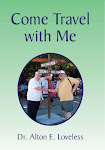
A Grave by Surprise
One of my desires in London was to visit the tomb of John Wesley near his home and the church where he preached many years ago. As my wife and I viewed the home, and then found the grave behind the church and the house, I inquired of the groundskeeper, where Mrs. Wesley was buried, after which he suggested that I go to the street and looked to the right and cross the street and go down through the Bunhill Field cemetery, where I would find her gravestone. Not only was I to find her stone, but would find the stones of other notable religious people whose history reflected itself in America.
I find it interesting to note that all the grave stones were small and just above the ground. I saw only two that were above the ground tombs. One was that of Daniel Defoe, who wrote Robinson Crusoe and the other John Bunyan, who had been imprisoned for twelve years for preaching without a license. It was while in prison, he wrote Pilgrim's Progress, an allegory of a man named Christian fleeing the City of Destruction and directed by Evangelist to follow a narrow path to the City of Zion. Unknown to many, it was the friends and dangers he meets along the way inspired the modern story Wizard of Oz.
This classic of John Bunyan, who died August 31, 1688, was translated into over a hundred languages and found in nearly every colonial American home.
Pilgrim’s progress has been read by many because it is such a classic and has been quoted by many great leaders, such as Ronald Reagan, when greeting Australia's Prime Minister, said: "Robert Louis Stevenson wrote, 'We are all travelers in what John Bunyan calls the wilderness of this world. And the best that we find in our travels is an honest friend-they keep us worthy of ourselves.'"
Also Franklin Roosevelt said: "When Theodore Roosevelt died, the Secretary of his class at Harvard, in sending classmates a notice of his passing, added this quotation
from Pilgrim's Progress: 'my sword I give to him that shall succeed me in my pilgrimage, and
My courage and skill to him that can get it. My marks and scars I carry with me, to be a witness for me that I have fought His battles who now will be my rewarder.'"
I have visited the graves of many great men but this memorial to one of Christianities great writers was a real blessing, especially since I was not searching for it but rather the grave of Susanna Wesley.
Afterwards, I found this bit of history and thought you might like a brief on this great man.
John was tried by magistrates in Chapel of Herne for not attending the parish church and for holding unlawful meetings. He was jailed for 3 months but, after just one month, he was visited by the magistrate’s clerk, who sought to persuade John to give a promise to cease preaching at 'private gatherings'. He told John that what the magistrates were concerned about was not the fact that John was not a licensed preacher but that he was preaching at conventicles) A secret or unlawful religious meeting, typically of people with nonconformist views.) These were private gatherings around England which the authorities suspected were being used as a cover for meetings where plots were being made to overthrow the King.
John argued that he had a higher obligation than to the king, that he had an obligation to God, to preach His word wherever and whenever he could. John argued that, if he promised not to preach in private places, this would prevent him - for example - from preaching to his neighbor in the privacy of his home and thus John would be failing in his obligation to God.
And there he remained, mostly, for the next 12 years. I find it interesting that in history people have done many great works, because in that same year Bunyan published “Profitable meditations”. In the years to follow he wrote and published “Praying in the Spirit”, “Christian behaviour”, “Serious meditations” , “Ebal & Gerizm”, “The Holy City”, “Resurrection of the dead” , “Prison meditations” , “Grace abounding” ,“Confession of faith” , “A defense of the doctrine of justification by faith”
In 1672 under King Charles' Declaration of Indulgence, John is released from prison and May 9th was licensed as a teacher. He was officially pardoned by Charles in September. John was elected church pastor and a barn at end of Mill Street, Bedford was purchased and this becomes his new chapel, but in 1675-6 John's preaching licenses are recalled was imprisoned for six months in Bedford County Goal where and he wrote the first part of “Pilgrim’s Progress” and in1684 the second part of “Pilgrim’s Progress” was published.
Of his works, “Grace Abounding”, “The Holy City”, and “Pilgrim’s Progress” are my favorites.
On August 31st, during a visit to a friend, John Strudwick, in London - John Bunyan contracted pneumonia and died. He was buried in Struthwick’s family tomb in Bunhill Fields, City Road, London.
“And how shall they preach unless they are sent? As it is written: "How beautiful are the feet of those who preach the gospel of peace, who bring glad tidings of good things!" -- Romans 10:15
From my weekly column.
Dr. Alton Loveless is the former CEO/President of Randall House Publications, Nashville, Tn.; He is a freelance writer and has written for assorted publications printed both nationally and internationally. To see photos and read other stories click on http://altonloveless.blogspot.com/





No comments:
Post a Comment